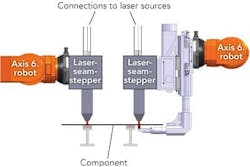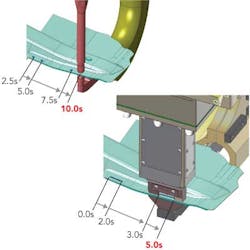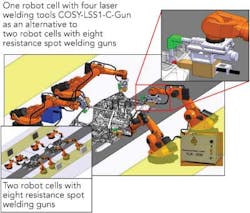Fiber laser spot welding
For today’s high volume production in the automotive industry, resistance spot welding and laser remote welding, while well established, present advantages and disadvantages. For laser remote welding the main advantage is the significant cycle time reduction due to almost complete elimination of idle times and the mechanical advantages of laser welded seams. For resistance spot welding an advantage is the integrated clamping technology, which comes nearly for free. IPG Laser GmbH (www.ipgphotonics.com) has combined these advantages in a new technology, COSY, offering the resistance spot welding process, featuring the simplicity of clamping tools and production facilities, used in combination with the advantages of laser welding.
A problem for some types of solid-state laser welding is operator safety, which requires a protective housing for lasers with power up to 6 kW. When used for welding sheet metal in the automotive industry, safety equipment with fast reaction safety devices is necessary. This complicates their use in an open production facility, for example in automotive body and assembly plants.
Laser welding for the production of sheet metal components in body plants offers the following advantages:
- Higher process speed (shorter cycle times)
- Increased component strength by longer seams with higher torsional stiffness
- Efforts and costs comparable to today’s modern resistance welding systems
- Realization of high job safety requirements with reduced costs
Fiber laser welding with a suitable welding tool provides the opportunity to accomplish all these objectives.
As shown in Figure 1, a Laser-Seam-Stepper (LSS1) module deflects the preset laser beam via a processing fiber into X-Y coordinates. For safety the laser beam is directed via funnel-shaped small angle housing. To release laser power, the housing has to contact the component to be welded.
FIGURE 1. Laser-Seam-Stepper (left without C-Gun; right with C-Gun)
Laser welding with or without a weaving function (±1 mm) can be produced within the range determined by the housing (standard = 40 mm). The easiest application is a module mounted for example on the 6th axis of an industrial robot (30 kg handling capacity). The robot moves the module to the required welding position. In this position it is placed onto the component only by robot force. Below the component, within the range of the welding seams, a fixed lower tooling is used as counter force or support (as shown in Figure 1 on the left).
During a typical stepping operation (30 mm welding seam, 30 mm free space, 30 mm welding seam, etc. ), a laser welding seam can be placed with a welding velocity of approximately 30 mm/s every 1.3 –1.5 seconds (see Figure 2).
FIGURE 2. Resistance spot welding vs. laser welding with COSY LSS1-C-Gun
The Laser-Seam-Stepper with C-Gun (LSS1C) is mounted on a servo motor driven traversing unit. This is similar to a resistance welding gun with compensating module (see Figure 1 right). This version allows an industrial robot (80 kg handling capacity) to move the LSS1C into a welding position and to close with a freely programmable force. The lower tool belonging to the C-gun is used as a counter force and additional safety equipment against unintended back reflected laser radiation.
The force-controlled closing of the laser welding system (0.5 – 3 kN) results in a fitting accuracy (gap < 0.2 mm) which is absolutely necessary for laser welding.
A module of the system compensates for tolerances regarding the position and geometry of the components. All joining forces (0.5 – 3 kN) applied in the system are performed within the laser welding tool only, the robot is not required for these joining forces. During a typical stepping operation a laser seam can be placed every 1.7 – 2 seconds.
Features of the laser welding tools, COSY LSS1/LLS1C, with a compact IPG fiber laser are:
- The mechanically compact design of the basic unit COSY-LSS1 can be moved by an industrial robot with a handling capacity of 30 kg.
- The basic version enables the system to weld linear seams with a maximum length of 40 mm.
- Optionally a weaving function (3 – 30 Hz) can be switched on in order to spread the welding seam (2 mm).
- Laser sources are very compact fiber laser systems with power between 500 W and 3 kW and a total efficiency of more than 30 %.
- The fiber laser and the welding head are maintenance free.
- The system is laser safe and can be used without complex laser protection housings. (Protective equipment as used in robot spot and arc welding cells is sufficient.)
- The LLS1C can join the sheet metal plates to be welded with a defined force in the area of the welding seam. This process reduces the normally high clamping effort during laser welding.
- The system is controlled via hardware interlock or buss systems. In the easiest case preconfigured seams of 10 mm – 40 mm seam length, including welding speed and laser power can be selected and started.
Typical applications for this system are sheet metal assemblies in the body-in-white production lines (see Figure 3), which up to now have been joined with many resistance welding spots. The intention of the COSY-LSS1and COSY-LSS1-C-Gun is to replace two welding spots with a typical distance of approximately 30 mm by one laser step seam of approximately 30 mm.
FIGURE 3. COSY LSS1-C-Gun with IPG fiber laser vs. resistance spot welding
For example in the case of 30 resistance spot welds the cycle time is approximately 75 seconds. If spot welding is replaced by laser welding in the manner described, only 15 laser weld seams are required. The cycle time can be reduced down to only 37 seconds in total, as well as the required floor space.
Dr Klaus Krastel ([email protected]) is with IPG Laser GmbH www.ipgphotonics.com.



